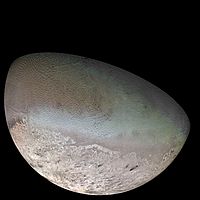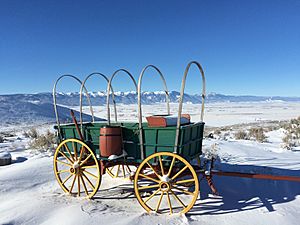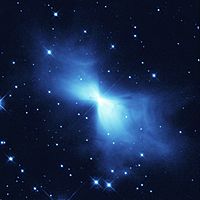Cold facts for kids
Cold is when something has a very low temperature. We often feel cold, especially when the air around us is chilly. How cold something feels can be different for everyone.
The lowest possible temperature is called absolute zero. This is 0.00 K on the Kelvin scale. It's the point where particles stop moving completely. This is the same as -273.15 °C on the Celsius scale and -459.67 °F on the Fahrenheit scale.
Temperature tells us about the thermal energy inside an object. This energy comes from the tiny particles inside the object moving around. When an object is colder, its particles move less, so it has less thermal energy. When it's hotter, the particles move more.
Contents
Cooling Things Down
Cooling means making something colder or lowering its temperature. You can do this by taking heat away from an object. Or, you can put the object in a place that is already colder than it is.
How We Cool Things
- Coolants are special liquids used to cool machines. They stop things from getting too hot or freezing.
- Air cooling works by letting air take heat away from an object. This works best if the air is cooler than the object. You can help it by making the object's surface bigger or its mass smaller.
- Using ice, dry ice (frozen carbon dioxide), or liquid nitrogen is another way to cool things. The heat moves from the warmer object to the colder ice or liquid.
- Scientists use special methods like laser cooling to reach extremely cold temperatures.
History of Cooling Technology
People have always found ways to keep things cold, especially food.
Ice Boxes and Refrigerators
In the 1800s, people started using ice boxes to keep food fresh. These were like wooden cabinets with a metal lining. Ice was placed inside to keep the food cool.
- In 1810, Thomas Moore invented one of the first ice boxes. He used it to carry butter.
- Nathaniel J. Wyeth invented a horse-drawn machine in 1825. This made cutting ice blocks much easier and cheaper.
- By the 1930s, the refrigerator became common in homes. These machines used electricity to keep food cold without needing ice blocks.
- In 1913, the first home refrigerators were invented.
- In 1923, Frigidaire made the first refrigerator that had all its parts in one unit.
- The invention of Freon in the 1920s helped refrigerators become even more popular.
- Separate home freezers were introduced in 1940. This made frozen foods easy to store and enjoy.
How Cold Affects Our Bodies
Cold temperatures can affect our bodies and how we feel.
- Shivering is one of the first ways our body reacts to cold. It's our body's way of trying to warm up.
- Being in extreme cold can lead to serious problems like frostbite. This is when parts of your body, like fingers or toes, freeze.
- Hypothermia is another danger. This happens when your body loses heat faster than it can make it. It can be very dangerous.
Super Cold Places and Objects
Some places in the universe and on Earth are incredibly cold!

- The Boomerang Nebula is the coldest known place in the universe. Scientists think it's about 1 K, which is -272.15 °C (-457.87 °F).
- Equipment on the Herschel Space Observatory is kept super cold, below 2 K. It uses a large tank of helium to stay cool.
- Neptune's moon Triton has a surface temperature of about -235 °C (-390 °F).
- The planet Uranus has an atmospheric temperature of about -215 °C (-355 °F).
- Saturn is about -175 °C (-285 °F) at its cloud tops.
- Even though Mercury is close to the Sun, it gets very cold at night. It can be around -170 °C (-275 °F). This is because it has no atmosphere to trap the Sun's heat.
- Jupiter is about -145 °C (-230 °F) at its cloud tops.
- Mars has a temperature of about -125 °C (-195 °F).
- The coldest continent on Earth is Antarctica. The coldest place on Earth is the Antarctic Plateau. The lowest temperature ever recorded there was -89.2 °C (-128.6 °F) at Vostok Station in 1983.
Images for kids
-
An iceberg, which is commonly associated with cold
-
Goose bumps, a common physiological response to cold, aiming to reduce the loss of body heat in a cold environment
-
A photograph of the snow surface at Dome C Station, Antarctica a part of the notoriously cold Polar Plateau, it is representative of the majority of the continent's surface
-
Cold desert of the Himalayas in Ladakh
See also
 In Spanish: Frío para niños
In Spanish: Frío para niños














